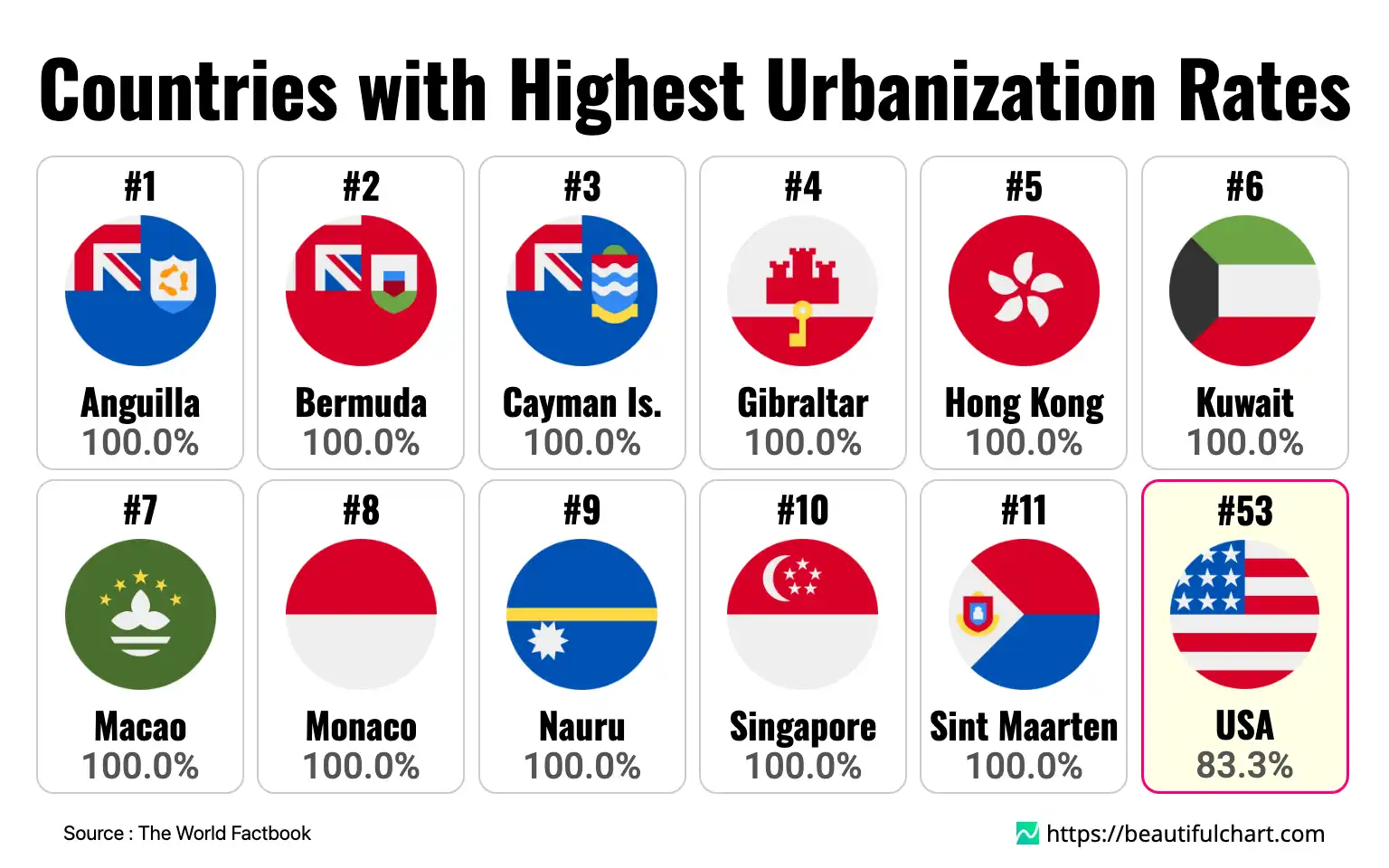A review of global population data reveals that twelve countries and territories, including Singapore, Hong Kong, and Monaco, have achieved a 100% urbanization rate, meaning their entire populations reside in urban areas. These are typically small city-states or territories where rural land is virtually nonexistent. In contrast, major economies like Japan and the United States show high but not complete urbanization, with rates of 92.0% and 83.3% respectively, reflecting a balance between major metropolitan centers and significant rural areas. This distribution highlights diverse patterns of human settlement and economic development across the globe.

The urbanization rate refers to the percentage of a country's total population that lives in areas classified as urban. It is a key indicator of economic and social development, as higher rates are often associated with industrialization, economic growth, and a shift away from an agriculture-based economy.
Urbanization is a defining demographic and social trend of the modern world, reflecting the large-scale movement of populations from rural to urban areas. This global shift is not uniform, with different nations exhibiting vastly different levels of urban concentration. The distribution of urban populations provides critical insights into economic structures, infrastructure development, and societal organization across the planet.
The Anatomy of 100% Urbanization
At the apex of the global urbanization list are a dozen entities, each boasting a 100% urban population. These are not sprawling continents but rather compact city-states, microstates, and dependent territories. Nations and regions such as Singapore, Monaco, Vatican City, Gibraltar, and Hong Kong fall into this category. Their complete urbanization is a direct consequence of their geography and economic function. As global hubs for finance, trade, or tourism, their entire land area is developed for urban living and commerce, leaving no space for traditional rural or agricultural activities. For these places, the country is the city, and the city is the country. This unique status makes them outliers in global demographic studies, representing the ultimate conclusion of the urbanization process.
Urbanization Patterns in Major Economies
In contrast to the city-states, the world's largest and most developed economies present a more complex picture. The United States, for instance, has an urbanization rate of 83.3%. While this figure is high and reflects a population concentrated in major metropolitan areas like New York, Los Angeles, and Chicago, it also signifies the persistence of vast rural areas that are crucial for agriculture, natural resources, and a distinct American way of life. Similarly, Japan, with a 92.0% urbanization rate, is one of the most urbanized large nations in the world, with a significant portion of its population living in the Tokyo-Yokohama metropolitan area. However, it still maintains important rural regions that are culturally and economically significant. Other G7 nations like the United Kingdom (84.6%), Germany (77.8%), and France (81.8%) follow a similar pattern, showcasing a mature stage of urbanization where the majority of the population is city-based, but a rural-urban divide remains a key feature of their national identity and economy.
The Dynamic Growth in Developing Nations
Emerging economies display some of the most dynamic urbanization trends. China's rate of 64.6% is particularly noteworthy, given that just a few decades ago, it was a predominantly rural society. This rapid shift has been fueled by unprecedented economic growth and industrialization, drawing hundreds of millions of people from the countryside to burgeoning megacities. This migration has powered China's economic miracle but has also created immense challenges related to housing, infrastructure, and environmental sustainability. Meanwhile, India's urbanization rate stands at 36.4%, indicating that it is still in an earlier phase of this transition. However, with its massive population, even this lower percentage translates to hundreds of millions of urban dwellers, and its cities are growing at a staggering pace. The trajectory of urbanization in these and other developing nations will be a primary determinant of global economic and environmental outcomes in the 21st century.
Factors and Implications
The drivers behind urbanization are multifaceted. Economic incentives, such as greater job opportunities and higher wages in cities, are the primary pull factors. Access to better education, healthcare, and cultural amenities also plays a significant role. As nations move from agrarian to industrial and service-based economies, the concentration of population in urban centers becomes an economic necessity. This ongoing global trend has profound implications for everything from resource management and climate change to social equity and political stability, making it a critical area of focus for policymakers worldwide.
Key Takeaways
The Dominance of City-States
- Twelve countries and territories, including Singapore, Monaco, and Hong Kong, have a 100% urbanization rate.
- This is primarily due to their small geographic size and status as city-states, where there is no distinction between urban and rural land.
- Their economies are typically focused on finance, trade, or tourism, further concentrating development in a single urban area.
Urbanization in Major Economies
- Large developed nations exhibit high but incomplete urbanization rates, such as the USA (83.3%), Japan (92.0%), and the UK (84.6%).
- This reflects a mature economy with dominant metropolitan centers alongside significant, and often protected, rural areas.
- The balance between urban and rural populations in these countries is a key feature of their economic and cultural landscape.
Global Urbanization Disparities
- There is a wide gap in urbanization levels between the most and least urbanized nations.
- Countries with lower rates, such as Papua New Guinea (13.7%) and Burundi (14.8%), often have economies that are more reliant on agriculture.
- Rapid urbanization in developing countries like China (64.6%) highlights a global trend of populations moving to cities in search of economic opportunities.
Top Ranking
#1 Anguilla 100.00%
As a small British overseas territory in the Caribbean, Anguilla's 100% urbanization rate is a function of its size and development focus. The island's economy is heavily reliant on luxury tourism and offshore financing, with development concentrated in small settlements that are urban in character. With a total area of just 91 square kilometers, there is no significant land area dedicated to large-scale agriculture, making the entire populated area effectively urban.
#1 Bermuda 100.00%
Bermuda is another British overseas territory whose 100% urbanization rate is driven by its small size and specialized economy. A global hub for insurance and reinsurance, its 54-square-kilometer area is highly developed. The population lives in a network of interconnected parishes that function as a single urban zone. The lack of a significant agricultural sector means the entire island is considered an urban environment.
#1 Cayman Is. 100.00%
The Cayman Islands, a British overseas territory, is one of the world's leading offshore financial centers. This economic focus has led to intensive development, particularly on the main island of Grand Cayman. With its population concentrated in and around the capital, George Town, and along the Seven Mile Beach corridor, the territory functions as a cohesive urban area. Its small landmass and service-based economy leave no room for a rural hinterland.
#1 Gibraltar 100.00%
Located on the southern tip of the Iberian Peninsula, Gibraltar is a British overseas territory with a land area of only 6.7 square kilometers. Its entire population lives within this highly dense urban area. The economy is based on tourism, financial services, and shipping, all of which are urban activities. The Rock of Gibraltar, a prominent landmark, is largely a nature reserve, but the habitable area is fully urbanized.
#1 Hong Kong 100.00%
Hong Kong, a Special Administrative Region of China, is one of the world's most densely populated places and a major global financial hub. Although it has large areas of protected country parks and mountains, its population is entirely concentrated in a vast urban agglomeration. The distinction between city and countryside does not apply in a conventional sense, as all residents live within a highly integrated and developed metropolitan system.
#1 Kuwait 100.00%
Kuwait's 100% urbanization rate is unique among larger sovereign states and is driven by its geography and oil-based economy. The vast majority of the country is desert, making it unsuitable for widespread settlement. As a result, the population is almost entirely concentrated in Kuwait City and its surrounding suburbs, which form a single, large urban area. The wealth generated from oil exports has fueled massive urban development.
#1 Macao 100.00%
Similar to Hong Kong, Macao is a Special Administrative Region of China known for its massive casino and tourism industry. With a tiny land area of about 33 square kilometers, it is one of the most densely populated regions in the world. Its entire territory is developed as an urban resort city, leaving no space for rural areas. The economy and lifestyle are entirely urban-focused.
#1 Monaco 100.00%
The Principality of Monaco, a sovereign city-state on the French Riviera, is the second-smallest country in the world. Its area of just over 2 square kilometers is completely urbanized. Known for its luxury casinos, yacht-lined harbor, and prestigious Grand Prix motor race, Monaco's economy and geography dictate a 100% urban environment. The entire country is essentially a single, high-density city.
#1 Nauru 100.00%
Nauru is a tiny island nation in Micronesia with an area of only 21 square kilometers. Decades of phosphate mining stripped the island's interior, rendering it largely unusable for agriculture and concentrating the population along the coastal fringe. This settlement pattern, combined with the island's small size, results in a 100% urbanization rate, as there is no rural or agricultural hinterland.
#1 Singapore 100.00%
The Republic of Singapore is a sovereign island city-state and a quintessential example of a 100% urbanized nation. Through meticulous urban planning, the entire island has been developed into a highly efficient and green metropolis. As a global hub for finance, trade, and technology with no rural areas, its entire population of nearly 6 million people lives in a high-density urban environment.
#1 Sint Maarten 100.00%
Sint Maarten is a constituent country of the Kingdom of the Netherlands, occupying the southern part of the Caribbean island of Saint Martin. Its economy is heavily dependent on tourism, with development concentrated around its cruise port and numerous resorts. The small land area and focus on tourism-related infrastructure mean that the entire territory is functionally urban, with no significant agricultural or rural zones.
#1 Vatican 100.00%
Vatican City is the world's smallest independent state, an enclave within Rome, Italy. With an area of just 0.44 square kilometers, it is entirely urban by nature. Its population consists mainly of clergy and officials who work for the Holy See. The entire territory is composed of buildings, squares, and gardens, with no rural or agricultural land, making it 100% urban by definition.
#53 USA 83.30%
The United States has an urbanization rate of 83.3%, placing it among the highly urbanized nations of the world. This reflects the concentration of its population in major metropolitan areas, from the Northeast Corridor to the West Coast's megacities. However, unlike smaller, more densely populated countries, the U.S. also possesses vast expanses of rural land dedicated to agriculture, conservation, and recreation. This urban-rural balance is a defining characteristic of the American landscape and economy, supporting both a modern, service-based urban society and a productive agricultural sector.
| Rank | Name | Indicator |
|---|---|---|
1 | 100.0% | |
1 | 100.0% | |
1 | 100.0% | |
1 | 100.0% | |
1 | 100.0% | |
1 | 100.0% | |
1 | 100.0% | |
1 | 100.0% | |
1 | 100.0% | |
1 | 100.0% | |
1 | 100.0% | |
1 | 100.0% | |
13 | 99.4% | |
14 | 98.2% | |
15 | 97.8% | |
16 | 96.2% | |
17 | 95.8% | |
18 | 95.2% | |
19 | 94.9% | |
20 | 94.2% |





